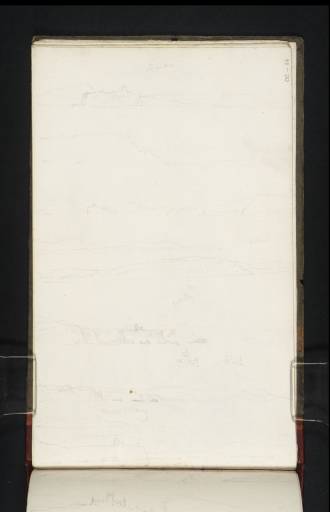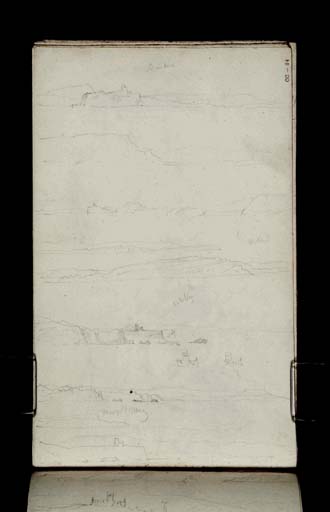Joseph Mallord William Turner Views of Scarbourgh, Robin Hood's Bay, Whitby and the Cliffs at Musgrave and Runswick 1822
Image 1 of 2
Joseph Mallord William Turner,
Views of Scarbourgh, Robin Hood's Bay, Whitby and the Cliffs at Musgrave and Runswick
1822
Joseph Mallord William Turner 1775–1851
Folio 84 Recto:
Views of Scarbourgh, Robin Hood’s Bay, Whitby and the Cliffs at Musgrave and Runswick 1822
D17656
Turner Bequest CC 84
Turner Bequest CC 84
Pencil on white wove paper, 187 x 114 mm
Inscribed in pencil by Turner ‘Scarbro’ top centre, ‘Robins’ centre right, ‘Whitby’ lower centre, ?‘Musgrave cliffs’ bottom centre
Stamped in black ‘CC 84’ top right running vertically
Inscribed in pencil by Turner ‘Scarbro’ top centre, ‘Robins’ centre right, ‘Whitby’ lower centre, ?‘Musgrave cliffs’ bottom centre
Stamped in black ‘CC 84’ top right running vertically
Accepted by the nation as part of the Turner Bequest 1856
References
1909
A.J. Finberg, A Complete Inventory of the Drawings of the Turner Bequest, London 1909, vol.I, p.613, CC 84, as ‘Off “Scarborough” and “Whitby”. See Water Colour of Whitby (170 N.G.) engraved by Lupton, and published, in “Ports of England,” 1 April, 1826.
1975
Malcolm Cormack, J.M.W. Turner, R.A. 1775–1851: A Catalogue of Drawings and Watercolours in the Fitzwilliam Museum, Cambridge, Cambridge 1975, p.48 note 2.
1979
Andrew Wilton, J.M.W. Turner: His Life and Work, Fribourg 1979, p.387.
1981
Gerald Finley, Turner and George the Fourth in Edinburgh 1822, exhibition catalogue, Tate Gallery, London 1981, pp.86, [227] reproduced as ‘Off “Scarborough” and “Whitby”. See watercolour of Whitby (National Gallery, 170), engraved by Lupton and published in Ports of England on 1 April 1826’.
1981
Eric Shanes, Turner’s Rivers, Harbours and Coasts, London 1981, p.152.
With the sketchbook turned to the left, Turner made sketches of the Yorkshire coast as he returned from Edinburgh by boat. There are similar sketches at the front of this sketchbook made on his outward journey (folios 3 verso and 4 verso; D17513, D17515). (For more information on Turner’s sea journey south see folio 78 verso; D17645).
Just before his boat reached Whitby, Turner made two sketches of the coastline to the north of the town. The second-from-bottom sketch may be of ‘Musgrave Cliffs’, a stretch of bays and headlands running for four or five miles just north of Whitby. The second sketch down may be of the cliffs at the west side of Runswick Bay (see folio 4 verso).
There are three sketches of Whitby on this page, The first, inscribed with the name of the town, is the sixth drawing down and gives prominence to the cliffs on which the town and St Hilda’s Abbey sit, and to the crags beneath them. The crags are also shown in the other two views of Whitby on this page: the seventh and bottom sketches. Turner also made two small but carefully executed studies of the abbey and St Mary’s Church, making up for the lack of detail in the coastal studies. Writers have tended to regard the three Whitby sketches on the present page as the foundation for Turner’s watercolour, Whitby, 1824 (Tate D18143; Turner Bequest CCVIII J).1 While these may have informed the picture, the sketch on folio 83 verso is in fact closer to the final composition. There are further sketches of Whitby on folio 87 (D17662).
Five miles further down the coast from Whitby is Robin Hood’s Bay, a fishing village that Turner also sketched on his journey north (folio 3 verso). On the present page are two sketches inscribed ‘Robin’. The fourth sketch down shows the bay and the stretch of coast to the north (right) up to Ness Point. The town itself is indicated by several box-shapes, shorthand that Turner used on his previous sketch of the town (folio 3 verso). The sketch below shows the steep cliffs above the bay.
Another nine miles south is Scarborough, and there are two sketches of the town on this page. The first view is the third sketch down and is from some distance to the north-east so that Castle Cliff appears as one of several headlands along the Yorkshire coast. On top of the cliff is the outline of Scarborough Castle. The second sketch at the top of the page was made from closer to and shows the headland and castle in more detail with Oliver’s Mount behind it to the left. There is a similar sketch of Scarborough on folio 88 (D17664).
Thomas Ardill
August 2008
How to cite
Thomas Ardill, ‘Views of Scarbourgh, Robin Hood’s Bay, Whitby and the Cliffs at Musgrave and Runswick 1822 by Joseph Mallord William Turner’, catalogue entry, August 2008, in David Blayney Brown (ed.), J.M.W. Turner: Sketchbooks, Drawings and Watercolours, Tate Research Publication, December 2012, https://www


